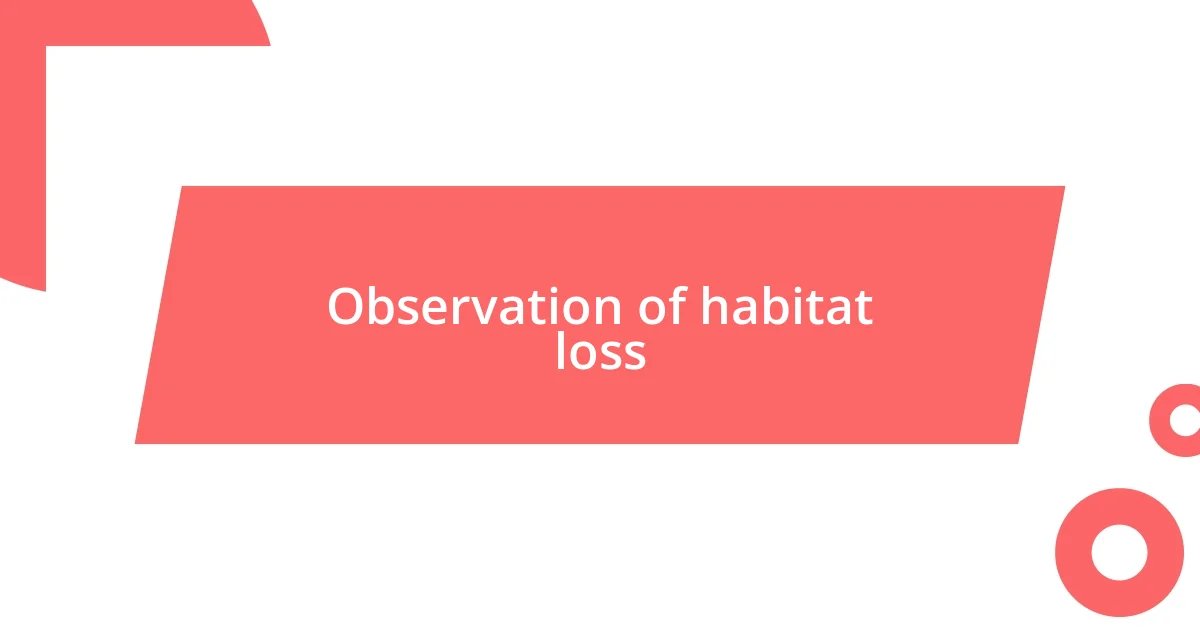Key takeaways:
- Witnessing firsthand the devastation of mining operations revealed the profound emotional and ecological costs of resource extraction, including habitat loss and community disconnection.
- Local activism showcased innovative strategies like tree-planting and social media campaigns, emphasizing the power of community collaboration in addressing environmental challenges.
- There is cautious optimism for the future of sustainable mining practices, driven by innovative technologies and a growing consumer demand for ethically sourced materials.

Introduction to ecological destruction
Ecological destruction is a phenomenon that feels both distant and personal, doesn’t it? I remember standing on the edge of a once-vibrant forest, now marred by extensive mining operations. The stark contrast between the lush greenery and the barren land left me questioning how we could let this happen.
As I witnessed the devastation firsthand, I couldn’t help but feel a deep sense of loss. Trees, which had stood for decades, were reduced to mere stumps, and the wildlife that called this place home was nowhere to be seen. This made me realize that every action we take has a ripple effect on our ecosystem, raising the question: at what cost does our pursuit of resources come?
Understanding ecological destruction goes beyond surface-level facts; it’s about recognizing the emotional weight of our choices. I still find myself grieving for those lost habitats, pondering how we can prioritize sustainability without sacrificing our natural world. Isn’t it time we re-evaluated our relationship with nature?

Personal experience with mining sites
During my visit to a mining site deep in the mountains, I was struck by the sheer scale of the destruction. The air was thick with dust, and the sound of heavy machinery drowned out any semblance of nature’s melody. I vividly recall chatting with a local resident who shared stories of how vibrant the landscape once was, filled with wildlife and flora. Their eyes reflected a profound sadness—something I could feel in my heart.
- The stark contrast between the mining machinery and the untouched landscape was alarming.
- Witnessing wildlife fleeing from their homes left me feeling helpless.
- The conversations I had with locals revealed a deep emotional impact on their community and culture.
- I realized that the invisible cost of our resource-driven economy is in the destruction of memories linked to these lands.

Observation of habitat loss
It’s shocking how habitat loss unfolds right before our eyes. I remember walking through what used to be a flourishing wetland, now reduced to a muddy expanse dotted with mining equipment. I felt an overwhelming sense of disarray; once a thriving ecosystem, it now echoed with the sounds of machinery—a stark reminder of what was lost.
When I encountered the remains of displaced animal homes, it left me with an aching emptiness. I once spotted a family of deer, startled and confused, looking for shelter among the scrap heaps; their bewilderment mirrored my own despair. This moment reinforced my realization that mining operations not only destroy habitats but also disrupt lives, forging a painful disconnect between nature and the creatures that depend on it.
The emotional burden of such observations often weighs heavily. For instance, I met an elderly woman who spoke fondly of the wetland, recounting childhood memories of playing near the water’s edge. Her sorrow brought to light how deeply these habitats are woven into our lives—representing not just landscapes, but generations of stories, joys, and experiences. Such reflections remind me that the cost of mining goes beyond the physical—it devastates emotional ties to our environment too.
| Scale of Habitat Loss | Impacts on Wildlife |
|---|---|
| Widespread destruction of forests and wetlands | Displacement of species, leading to extinction risks |
| Reduction of biodiversity in affected areas | Alteration of migration routes and breeding grounds |

Impact on local water sources
Witnessing the impact of mining on local water sources was profoundly unsettling. One afternoon, while exploring a once-pristine creek, I found it muddied and choked with debris. I couldn’t help but wonder, where had the crystal-clear waters gone? The locals I spoke with lamented about fishing in the very same creek during their childhood, and now they struggled to find a single fish swimming in the murky depths.
As I stood beside the creek, I saw firsthand the run-off from the mining operations staining the water. This wasn’t just a physical change; it was a gradual loss of livelihood for many families reliant on fishing. One father recounted how he used to bring home fresh catches for his children, laughter spilling from their home. Now, he hesitated to even let them play near the water, fearing the unseen toxins lurking below the surface. You really start to grasp the weight of this destruction when you realize it’s not just water being affected, but entire communities’ connections to their land.
I still remember the day I picked up a water sample with a local environmentalist. The look on his face when he scanned the results revealed an unsettling truth: the water was laced with heavy metals. This moment struck me; how could something so vital to life be so tainted? I walked away feeling an urgent need for change. It became clear that the effects of mining on water sources went far beyond contamination. They reached into the very fabric of local cultures and traditions, reshaping identities intertwined with those waters. Isn’t it tragic that we often don’t realize what we take for granted until it’s gone?

Mitigation strategies employed by activists
Activists have employed various mitigation strategies to counter mining’s devastating impacts. I recall attending a community meeting where passionate locals gathered to share ideas. Some advocated for stricter regulations, urging the government to enforce existing environmental laws, while others proposed educational programs for the youth. It struck me how collaboration can amplify voices and spur change; it’s a reminder that we don’t have to face these challenges alone.
I was particularly moved during a tree-planting event organized by a local environmental group. Watching volunteers dig holes to reintroduce native species to the area felt like a small but meaningful act of rebellion against the destruction. The air was heavy with hope as we reminisced about what once thrived there. Comments flowed freely, like “If we can restore even a part of that beauty, it’s worth every hour we spend.” It made me realize that these grassroots efforts often unite us in purpose, reigniting our connection with the land.
In another instance, I chatted with some activists who were tirelessly raising awareness through social media. Their campaigns were incredibly effective, attracting young people who might otherwise have felt disconnected from the issue. One activist shared how a viral post had led to a surge in support for local conservation projects. It got me thinking: how powerful can a collective digital voice be? With every share and retweet, they create a ripple effect, transforming awareness into action. Such strategies exemplify how we can leverage modern tools for a cause that feels deeply personal yet surprisingly broad.

Future of sustainable mining practices
As I look toward the future of sustainable mining practices, I can’t help but feel a sense of cautious optimism. I recently learned about innovative technologies that could revolutionize the industry. For instance, some companies are investing in methods like bioremediation, which uses living organisms to clean up contaminated sites. Can you imagine a future where nature repairs the damage we’ve inflicted upon it?
Experiencing community efforts in advocating for sustainable methods brought me immense hope. I joined a workshop where experts shared their insights on reduced-impact mining techniques. The energy in the room was palpable, with participants sparked by the possibility of creating a more responsible industry. I found myself reflecting on how collective knowledge and action can transform an entire sector. It’s not just about protecting our resources; it’s about changing our mindset around extraction and consumption.
Moreover, I’ve observed a shift in consumer attitude, with many demanding ethically sourced materials. At a local fair, I encountered artisans proudly showcasing their products made from sustainably sourced materials. I was struck by how much people value transparency and ethical practices. Wouldn’t it be astounding if every mining operation prioritized sustainability just as fiercely? This grassroots activism is a powerful reminder that the future of mining doesn’t have to repeat the mistakes of the past; we can build a thriving industry that respects both people and the planet.















